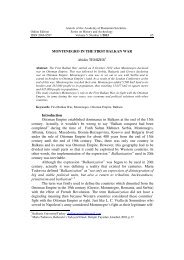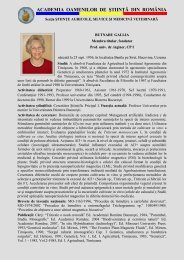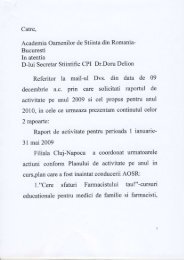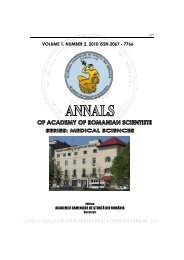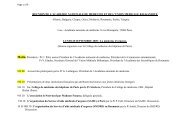Volume 3 nr 1 / 2011 - Academia Oamenilor de Stiinta din Romania
Volume 3 nr 1 / 2011 - Academia Oamenilor de Stiinta din Romania
Volume 3 nr 1 / 2011 - Academia Oamenilor de Stiinta din Romania
- No tags were found...
You also want an ePaper? Increase the reach of your titles
YUMPU automatically turns print PDFs into web optimized ePapers that Google loves.
General Consi<strong>de</strong>rations Regar<strong>din</strong>gthe Impact of the Vidraru Lake Hydro Facilities on the Environment 61The water passing through the hydroelectric turbines flows into the Oesti Lake,downstream from it [2].The Vidraru Lake, together with the lakes on the bank of the Dâmboviţa River(e.g. Pecineagu, Sătic), is part of the Bucharest water supply system [11].2. Physical-geographical characteristicsIn terms of lithology, the Vidraru Dam is built mostly on crystalline rocks, namelygneiss (the Cozia gneisses), paragneiss, and hard rocks, that are resistant andwater-repellent.By its geographical position, the terrain of the drainage basin of the Vidraru Lakeis characteristic of the high mountain area (Moldoveanu Peak, 8,346 ft., andNegoiu Peak, 6,713 ft.), with a crystalline structure affected by the quaternaryglaciation that left glacial cirques at the top source of those two tributaries, Capraand Buda, harbouring the homonymous glacial lakes [6].The lake basin is mostly based on Loviştea Depression, in its eastern extension,where the heights are below 4,921 ft. (Lăcşor Peak, 4,829 ft., Haţeganu Peak,4,396 ft.), and the lower part is located on the southern alignment of the FăgăraşMassif (Ghiţu Peak, 5,321 ft., in the east, and Frunţi Peak, 5,032 ft., in the west)[10] (fig. 2.).The climate is influenced and <strong>de</strong>termined by the movement of air masses, altitu<strong>de</strong>and configuration of the terrain, but also by the existence of the Vidraru Lake that<strong>de</strong>termines a topoclimate characterized by mo<strong>de</strong>rate temperatures, high humidityand a local air circulation in the form of local mountain – valley winds.The average annual temperature is 6.0 o C, the lowest value being recor<strong>de</strong>d inJanuary (-2.4 o C), and the highest in July (16.1 o C).Thus, the winter months (December, January and February) show temperaturesbelow 0 o C. The average annual <strong>de</strong>pth of precipitation is 770 mm.The average annual wind speed is 0.9 m/s, the highest one being in March(1.2 m/s) and the lowest one in December (0.6 m/s). The number of days withsnow cover is 101, with a maximum in January (27 days), followed by February(24 days), March (17 days) and fewer days in April, November and December,and the largest thickness is recor<strong>de</strong>d in January and February, i.e. 15 to 20 cm[13].The lake-related hydrographic network is represented by two main tributaries:Buda (22.6 km) and Capra (20 km) that interflow in the upper part of the lakewith the top source in the homonymous glacial lakes [8].Other tributaries of the lake are Cumpăna, Valea lui Stan, Oticul, Valea cu Peşti.Copyright © Editura Aca<strong>de</strong>miei <strong>Oamenilor</strong> <strong>de</strong> Știință <strong>din</strong> România, <strong>2011</strong>Watermark Protected



